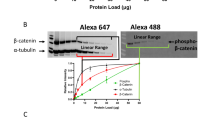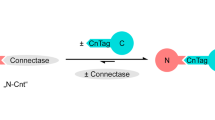Abstract
Two-dimensional difference gel electrophoresis (2D DIGE) is a modified form of 2D electrophoresis (2DE) that allows one to compare two or three protein samples simultaneously on the same gel. The proteins in each sample are covalently tagged with different color fluorescent dyes that are designed to have no effect on the relative migration of proteins during electrophoresis. Proteins that are common to the samples appear as 'spots' with a fixed ratio of fluorescent signals, whereas proteins that differ between the samples have different fluorescence ratios. With the appropriate imaging system, DIGE is capable of reliably detecting as little as 0.5 fmol of protein, and protein differences down to ± 15%, over a >10,000-fold protein concentration range. DIGE combined with digital image analysis therefore greatly improves the statistical assessment of proteome variation. Here we describe a protocol for conducting DIGE experiments, which takes 2–3 d to complete.
This is a preview of subscription content, access via your institution
Access options
Subscribe to this journal
Receive 12 print issues and online access
$259.00 per year
only $21.58 per issue
Buy this article
- Purchase on Springer Link
- Instant access to full article PDF
Prices may be subject to local taxes which are calculated during checkout




Similar content being viewed by others
References
O'Farrell, P.H. High resolution two-dimensional electrophoresis of proteins. J. Biol. Chem. 250, 4007–4021 (1975).
Scheele, G.A. Two-dimensional gel analysis of soluble proteins. Characterization of guinea pig exocrine pancreatic proteins. J. Biol. Chem. 250, 5375–5385 (1975).
Klose, J. Protein mapping by combined isoelectric focusing and electrophoresis of mouse tissues. A novel approach to testing for induced point mutations in mammals. Humangenetik 26, 231–243 (1975).
Gorg, A., Postel, W. & Gunther, S. The current state of two-dimensional electrophoresis with immobilized pH gradients. Electrophoresis 9, 531–546 (1988).
Hamdan, M. & Righetti, P.G. Proteomics Today: Protein Assessment and Biomarkers using Mass Spectrometry, 2D Electrophoresis, and Microarray Technology (John Wiley & Sons, Hoboken, New Jersey, 2005).
Unlu, M., Morgan, M.E. & Minden, J.S. Difference gel electrophoresis: a single gel method for detecting changes in protein extracts. Electrophoresis 18, 2071–2077 (1997).
Lilley, K. in Current Protocols in Protein Science (eds. Coligan, J.E., Dunn, B.M., Speicher, D.W. & Wingfield, P.T.) 22.2.1–22.2.14 (John Wiley & Sons, Inc., New York, 2002).
Gong, L. et al. Drosophila ventral furrow morphogenesis: a proteomic analysis. Development 131, 643–656 (2004).
Shaw, M.M. & Riederer, B.M. Sample preparation for two-dimensional gel electrophoresis. Proteomics 3, 1408–1417 (2003).
Marouga, R., David, S. & Hawkins, E. The development of the DIGE system: 2D fluorescence difference gel analysis technology. Anal. Bioanal. Chem. 382, 669–678 (2005).
Okano, T. et al. Plasma proteomics of lung cancer by a linkage of multi-dimensional liquid chromatography and two-dimensional difference gel electrophoresis. Proteomics 6, 3938–3948 (2006).
Wang, H. et al. Intact-protein-based high-resolution three-dimensional quantitative analysis system for proteome profiling of biological fluids. Mol. Cell Proteomics 4, 618–625 (2005).
Kondo, T. et al. Application of sensitive fluorescent dyes in linkage of laser microdissection and two-dimensional gel electrophoresis as a cancer proteomic study tool. Proteomics 3, 1758–1766 (2003).
Sitek, B. et al. Novel approaches to analyse glomerular proteins from smallest scale murine and human samples using DIGE saturation labelling. Proteomics 6, 4506–4513 (2006).
Zhou, G. et al. 2D differential in-gel electrophoresis for the identification of esophageal scans cell cancer-specific protein markers. Mol. Cell Proteomics 1, 117–124 (2002).
Karp, N.A. & Lilley, K.S. Maximising sensitivity for detecting changes in protein expression: experimental design using minimal CyDyes. Proteomics 5, 3105–3115 (2005).
Tonge, R. et al. Validation and development of fluorescence two-dimensional differential gel electrophoresis proteomics technology. Proteomics 1, 377–396 (2001).
Yan, J.X. et al. Fluorescence two-dimensional difference gel electrophoresis and mass spectrometry based proteomic analysis of Escherichia coli . Proteomics 2, 1682–1698 (2002).
Bertin, E. & Arnouts, S. SExtractor: software for source extraction. Astron. Astrophys. 117, 393–404 (1996).
Suehara, Y. et al. Proteomic signatures corresponding to histological classification and grading of soft-tissue sarcomas. Proteomics 6, 4402–4409 (2006).
Shaw, J. et al. Evaluation of saturation labelling two-dimensional difference gel electrophoresis fluorescent dyes. Proteomics 3, 1181–1195 (2003).
Zhou, S., Bailey, M.J., Dunn, M.J., Preedy, V.R. & Emery, P.W. A quantitative investigation into the losses of proteins at different stages of a two-dimensional gel electrophoresis procedure. Proteomics 5, 2739–2747 (2005).
Author information
Authors and Affiliations
Corresponding author
Ethics declarations
Competing interests
JM has a conflict of interest with respect to DIGE and the ProteoHook protein clean up kit. These methods were developed in the Minden lab and licensed to Amersham and Proteopure, respectively. JM receives royalties for DIGE from Amersham and options from Proteopure. SV is an employee of Proteopure.
Supplementary information
Supplementary Video 1
DIGE movie. Shown here is a two-frame, looping movie comparing different mouse cell extracts. (MOV 195 kb)
Rights and permissions
About this article
Cite this article
Viswanathan, S., Ünlü, M. & Minden, J. Two-dimensional difference gel electrophoresis. Nat Protoc 1, 1351–1358 (2006). https://doi.org/10.1038/nprot.2006.234
Published:
Issue Date:
DOI: https://doi.org/10.1038/nprot.2006.234
Comments
By submitting a comment you agree to abide by our Terms and Community Guidelines. If you find something abusive or that does not comply with our terms or guidelines please flag it as inappropriate.



